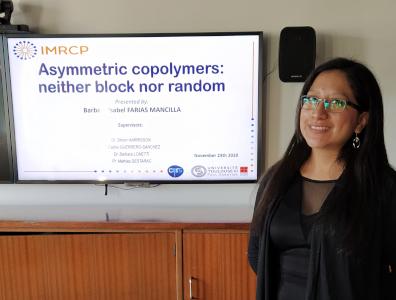Barbara Farias-Mancilla, PhD student at IMRCP, has defended her thesis on asymmetric copolymers

Barbara carried out her research in the P3R team at the IMRCP laboratory.
On November 24th, she defended her thesis entitled: "Asymmetric copolymers: neither block nor random".
Block copolymers are made from polymer chains of different chemical composition that are covalently joined via their respective end groups. On the other hand, there are statistical copolymers in which two or more monomers are distributed statistically along the chain in a manner that is independent of their position. Between these structures exist asymmetric copolymers, which are defined as a distribution of monomers within the chain which is neither completely segregated as for a block copolymer nor statistically distributed in the case of statistical copolymers. Based on this, the properties of asymmetric copolymers are expected to combine characteristics of block and statistical structures.
In this investigation, acrylic acid―(n-butyl acrylate) (AA―n-BA) copolymers and dimethylacrylamide―N-isopropylacrylamide (DMA―NIPAM) copolymers were obtained by RAFT polymerization using forced and stepwise synthesis. The composition of the copolymers was always the same, however the distribution of the monomer units within the chain was different.
Both copolymer systems are stimuli-responsive polymers. Stimuli-responsive polymers or smart polymers are macromolecules which undergo phase transitions in response to changes in the environmental conditions. AA―n-BA copolymers are pH-responsive and DMA-NIPAM copolymers are thermosensitive. Block, statistical, gradient, diblock and triblock structures were obtained with the aim of comparing their physicochemical properties in solution. The macromolecular characteristics of copolymers were obtained by nuclear magnetic resonance spectroscopy (1H NMR) and gel permeation chromatography (GPC).
AA―n-BA copolymers in solution at different pH were studied by DLS, cryo-TEM and small angle neutron scattering (SANS) and it was possible to demonstrate the changes in size and self-assembly behavior as a function of pH of the copolymer solutions. The results showed that the AA―n-BA asymmetric copolymers form aggregates of different morphology depending on the pH, for example vesicles at pH 4 or micelles and worms at pH 5. On the other hand, the morphology of block copolymers with the same composition is not influenced by changes in pH.
DMA―NIPAM copolymers in solutions were analyzed by DLS, SANS and 1H NMR as a function of temperature. The evolution of hydrodynamic size as a function of temperature could be followed by DLS and SANS whereas the phase separation of copolymers from solution was analyzed by 1H NMR. For all copolymers, hydrodynamic size increase with temperature. Gradient copolymers of 20 and 40 kg/mol showed a reel-in effect when heating above the LCST.
Highlight of the thesis:
> 4 papers have been published, including 2 for which Barbara is 1st author, and 1 in Angewandte Chemie (IF 2019: 12.959):
- Effect of hydrophilic monomer distribution on self‐assembly of a pH‐responsive copolymer: spheres, worms and vesicles from a single copolymer composition
Zhang J.; Farias‐Mancilla B.; Kulai I.; Hoeppener S.; Lonetti B.; Prévost S.; Ulbrich J.; Destarac M.; Colombani O.; Schubert U.S.; Guerrero‐Sanchez C.; Harrisson S.
Angew. Chem. Int. Ed., 2020, DOI
- Gradient and asymmetric copolymers: the role of the copolymer composition profile in the ionization of weak polyelectrolytes
Farias-Mancilla B.; Zhang J.; Kulai I.; Destarac M.; Schubert U.S.; Guerrero-Sanchez C.; Harrisson S.; Colombani O.
Polym. Chem., 2020, DOI
- Synthesis of PMMA-based block copolymers by consecutive irreversible and reversible addition–fragmentation chain transfer polymerizations
Bergerbit C.; Farias-Mancilla B.; Seiler L.; Monteil V.; Harrisson S.; D'Agosto F.; Destarac M.
Polym. Chem., 2019,10, 6630-6640, DOI
- Asymmetric copolymers: synthesis, properties, and applications of gradient and other partially segregated copolymers
Zhang J.; Farias‐Mancilla B.; Destarac M.; Schubert U. S.; Keddie D. J.; Guerrero‐Sanchez C.; Harrisson S.
Macromol. Rapid Commun., 2018, 39, 1800357, DOI
Congratulations to Barbara for the quality of her work!


